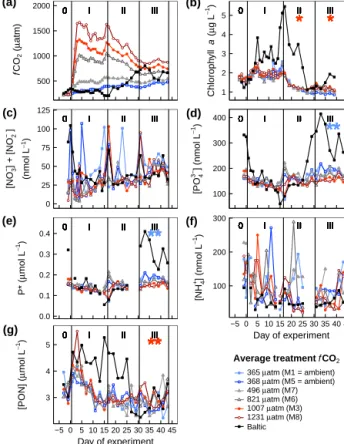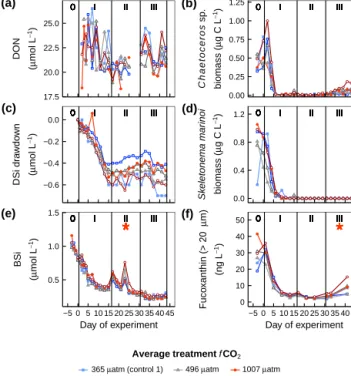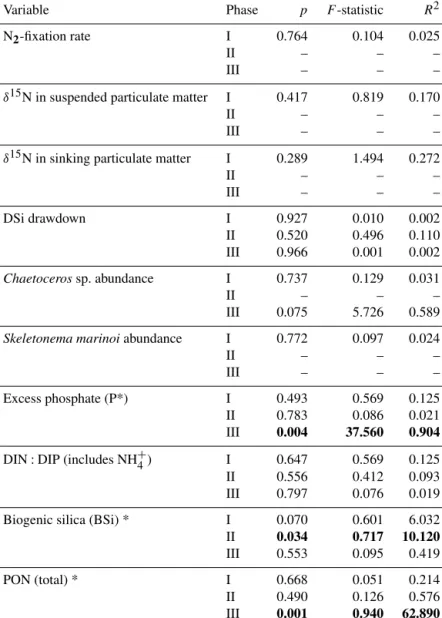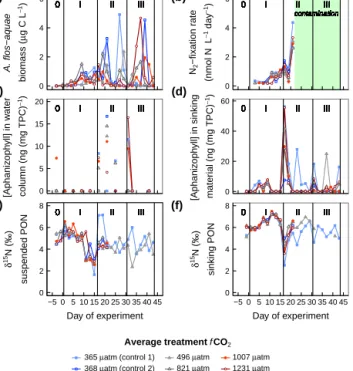www.biogeosciences.net/13/3901/2016/
doi:10.5194/bg-13-3901-2016
© Author(s) 2016. CC Attribution 3.0 License.
No observed effect of ocean acidification on nitrogen
biogeochemistry in a summer Baltic Sea plankton community
Allanah J. Paul1, Eric P. Achterberg1,2, Lennart T. Bach1, Tim Boxhammer1, Jan Czerny1, Mathias Haunost1, Kai-Georg Schulz1,3, Annegret Stuhr1, and Ulf Riebesell1
1GEOMAR Helmholtz Centre for Ocean Research Kiel, Düsternbrooker Weg 20, 24105 Kiel, Germany
2National Oceanography Centre Southampton, European Way, University of Southampton, Southampton, SO14 3ZH, UK
3Southern Cross University, Military Road, East Lismore, NSW 2480, Australia Correspondence to:Allanah J. Paul (apaul@geomar.de)
Received: 5 October 2015 – Published in Biogeosciences Discuss.: 30 October 2015 Revised: 17 May 2016 – Accepted: 29 May 2016 – Published: 7 July 2016
Abstract. Nitrogen fixation by filamentous cyanobacteria supplies significant amounts of new nitrogen (N) to the Baltic Sea. This balances N loss processes such as denitrification and anammox, and forms an important N source support- ing primary and secondary production in N-limited post- spring bloom plankton communities. Laboratory studies sug- gest that filamentous diazotrophic cyanobacteria growth and N2-fixation rates are sensitive to ocean acidification, with po- tential implications for new N supply to the Baltic Sea. In this study, our aim was to assess the effect of ocean acidifi- cation on diazotroph growth and activity as well as the con- tribution of diazotrophically fixed N to N supply in a natural plankton assemblage. We enclosed a natural plankton com- munity in a summer season in the Baltic Sea near the en- trance to the Gulf of Finland in six large-scale mesocosms (volume∼55 m3)and manipulatedfCO2over a range rele- vant for projected ocean acidification by the end of this cen- tury (average treatment fCO2: 365–1231 µatm). The direct response of diazotroph growth and activity was followed in the mesocosms over a 47 day study period during N-limited growth in the summer plankton community. Diazotrophic fil- amentous cyanobacteria abundance throughout the study pe- riod and N2-fixation rates (determined only until day 21 due to subsequent use of contaminated commercial 15N-N2gas stocks) remained low. Thus estimated new N inputs from di- azotrophy were too low to relieve N limitation and stimulate a summer phytoplankton bloom. Instead, regeneration of or- ganic N sources likely sustained growth in the plankton com- munity. We could not detect significant CO2-related differ- ences in neither inorganic nor organic N pool sizes, or partic-
ulate matter N:P stoichiometry. Additionally, no significant effect of elevated CO2on diazotroph activity was observed.
Therefore, ocean acidification had no observable impact on N cycling or biogeochemistry in this N-limited, post-spring bloom plankton assemblage in the Baltic Sea.
1 Introduction
Nitrogen (N) is an essential element for cell functioning in the biosphere due to its presence in many important biomolecules such as nucleic acids and proteins. However, in many marine ecosystems N is considered the limiting nu- trient for important cellular processes in phytoplankton (Vi- tousek and Howarth, 1991), as indicated through stimulation carbon fixation and pigment synthesis through addition of in- organic N (e.g. Moore et al., 2008, 2013). This low N avail- ability also prevails in post-spring bloom plankton communi- ties in the Baltic Sea, as the nitrate pool is exhausted during the spring bloom, leaving behind an excess of dissolved inor- ganic phosphorus (Wasmund et al., 2001). Consequently, fil- amentous diazotrophic (N2-fixing) cyanobacteria, in particu- lar heterocystousNodularia spumigenaandAphanizomenon flos-aquae, capitalise on this excess phosphate and increas- ing water column temperatures in summer months (Kononen et al., 1996; Pli´nski and Jó´zwiak, 1999; Wasmund, 1997) and commonly form extensive blooms and surface aggre- gations (e.g. Kahru and Elmgren, 2014). The atmospheric nitrogen gas (N2)fixed by these heterocystous cyanobacte- ria during the summer months forms a key N source for the
wider plankton community in the Baltic Sea, since a signif- icant fraction of the fixed N can be released as ammonium (Ohlendieck et al., 2000; Ploug et al., 2010; Stal et al., 2003;
Wannicke et al., 2013) and dissolved organic N compounds (Ohlendieck et al., 2000, 2007; Wannicke et al., 2013). Thus in addition to N in diazotroph biomass, newly fixed N is also available for direct assimilation by phytoplankton and bacte- ria and is estimated to support up to 20–45 % of annual pri- mary production in the Baltic Sea (Gustafsson et al., 2013).
This new N input partly replenishes N loss processes such as anammox and denitrification in the deep anoxic basins (Vahtera et al., 2007). Furthermore, this fixed N can also be directly transferred to higher trophic levels through grazing by zooplankton (Engström-Öst et al., 2011; Hogfors et al., 2014; Wannicke et al., 2013).
Changes in seawater carbonate chemistry due to increased atmospheric CO2 concentrations are expected to induce changes in phytoplankton physiology. The associated de- crease in seawater pH is called ocean acidification. Numer- ous single-strain culture studies have investigated the phys- iological responses of a variety of diazotrophic organisms and generally indicated increased N2-fixation and diazotroph growth rates under elevated CO2 (Barcelos e Ramos et al., 2007; Fu et al., 2008; Hutchins et al., 2007; Kranz et al., 2010; Levitan et al., 2007), with contrasting evidence un- der iron limitation (Shi et al., 2012) and with freshwater strains of A. flos-aquae (Yamamoto and Nakahara, 2005).
Three studies on the common Baltic Sea species,N. spumi- gena, produced contrasting results with two studies under phosphate repletion suggesting a negative effect (Czerny et al., 2009; Eichner et al., 2014), and one study, under low inorganic phosphate availability, indicating a positive effect (Wannicke et al., 2012) of increased CO2on growth and N2- fixation rates. This discrepancy may, however, be due to dif- ferences in phosphate availability (Eichner et al., 2014). Con- sidering the contribution of diazotrophs to the N budget and primary productivity in the Baltic Sea, it is vital to understand the influence of future changes inpCO2on new N inputs by diazotrophs.
In this mesocosm study, our aim was to assess diazotroph growth and rates of N2-fixation under a range of CO2con- centrations in a natural plankton community. N limitation of phytoplankton growth was reported in the study area in the Finland Archipelago Sea (Kirkkala et al., 1997; Tamminen and Andersen, 2007). By utilising the naturally occurring low N conditions in the Baltic Sea we wanted to examine the im- portance of new N inputs by diazotrophic organisms to the wider plankton community N supply under projected future ocean acidification scenarios.
2 Materials and methods
2.1 Experimental set-up and sampling
The study took place in the period between June and Au- gust 2012 in Tvärminne Storfjärden, which is situated in the Archipelago Sea on the southwestern tip of Finland.
Six pelagic mesocosms (total volume ∼55 m3, Kiel Off- Shore Mesocosms for future Ocean Simulations – KOSMOS, Riebesell et al., 2013) were deployed on 12 June 2012 (day of experiment−10=t−10, i.e. 10 days before CO2manip- ulation) and moored at 59◦51.50N, 23◦15.50E. The cylindri- cal mesocosm bags of 2 m in diameter extended from 1.5 m above to 19 m below the water surface and were closed at the bottom by a 2 m long sediment trap funnel ont−5. A 3 mm net was used to exclude larger organisms or particles before mesocosm closure.
A gradient of CO2treatments across the mesocosms was established over a 4 day period by additions of filtered (50 µm), CO2-saturated seawater evenly distributed in the water column, as described by Riebesell et al. (2013). CO2 additions were carried out in the afternoons oft0–t4, so as to not interfere with the daily sampling. A CO2 addition was also made in the upper 7 m on t15 to counter strong out- gassing in the upper water column. InitialfCO2ranged from
∼240 µatm in the two ambient control mesocosms to up to 1650 µatm (Fig. 1a). Unenriched filtered (50 µm) seawater was added to the two control mesocosms (M1, M5). The sea- water used for the additions to the mesocosms was collected from the Tvärminne Storfjärden from a depth of 10 m by a pipe connected to the laboratory at the research station.
Depth-integrating water samplers (IWS, HYDRO-BIOS, Kiel) were used to collect water from 0 to 17 m depth in each mesocosm for analysis of particulate matter, dissolved inorganic and organic matter, phytoplankton pigments, phy- toplankton abundances and carbonate chemistry variables.
Samples of carbonate chemistry variables were taken di- rectly from the IWS on board the sampling boat, whereas all other samples were pooled in 10 L plastic carboys and stored on board in the dark until subsampling onshore (Paul et al., 2015). Particulate matter collected in the sediment trap was pumped to the surface and collected in sampling bottles (Boxhammer et al., 2016).
Particulate matter (C, N, P) and phytoplankton pigment samples were collected onto GF/F filters (nominal pore size of 0.7 µm, 25 mm diameter, Whatman) by gentle vacuum fil- tration (pressure < 200 mbar). Filters and glass Petri dishes were combusted at 450◦C for 6 h before use. Collected par- ticulate sediment material was concentrated, freeze-dried and ground to a homogenous powder, while supernatant sub- samples were filtered and subsequently analysed as for wa- ter column material. Total particulate carbon and nitrogen (TPC and PON) content and isotopic composition were anal- ysed according to Sharp (1974) using an elemental anal- yser (EuroEA) coupled by either a Conflo II to a Finnigan



